|
COLORADO FIRE EVACUATES MOUNTAIN TOWNJULY 08 -- GREENWOOD, CO: Some residents of the town of Greenwood woke up this morning to reverse 9-1-1 calls, and others were roused by a door-to-door campaign by emergency personnel. The Denver Post reported that 50 homes were evacuated and the fire has grown to 250 acres.
KRDO-TV reported that
many residents were put on notice last night that evacuations were pending. The lightning-caused Mason Fire was at 200 acres last night, burning south of Wetmore on the San Isabel Natioal Forest. Steep slopes, inaccessible terrain, a lack of safety zones, and heavy fuels were challenging firefighters, according to Hessler's Type 3 team.
Tankers 48 and 20 flew the fire yesterday, with at least two helicopters and T-48 and T-20 and T-44 on it this morning. (KOAA-TV has a couple of nice photos.) Almost 100 firefighters were working the fire.
Dry thunderstorms, low humidity, and gusty erratic winds are forecast for the area.

ITALIAN CRANE CRASH KILLS OREGON MECHANICJULY 08 -- CENTRAL POINT, OR: A Rogue River man was killed Wednesday when an Erickson Air-Crane crashed during a test flight at a Rome airport. Three others on board were injured. Marty Erickson, a mechanic, died in the crash; mechanic Troy Niemeyer of Eagle Point received minor injuries. Pilot Chris Woods of Washington state and Italian pilot Floriano Finmore also received minor injuries.
The helicopter went down shortly after take-off during a hover-controllability check. It was one of four built by Erickson in Central Point for the Italian forest service.
Marty Erickson, a long-time employee, was not related to the company’s founders.

RATTLESNAKE FIRE OVERLOOK DEDICATION ON SATURDAY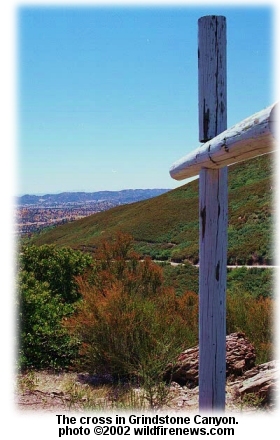 JULY 07 -- WILLOWS, CA: The Mendocino National Forest plans a ceremony at 10:00 a.m. Saturday in memory of the 1953 Rattlesnake Fire, which killed 15 firefighters in Grindstone Canyon near the town of Elk Creek on the Mendocino. JULY 07 -- WILLOWS, CA: The Mendocino National Forest plans a ceremony at 10:00 a.m. Saturday in memory of the 1953 Rattlesnake Fire, which killed 15 firefighters in Grindstone Canyon near the town of Elk Creek on the Mendocino.
A new informational and training site overlooks the site in Grindstone Canyon; a new parking area leads to a trail that follows the routes of the firefighters on the Rattlesnake Fire. The Mendocino Hotshots will lead hikes on the trail.
Shuttle service will be available from Gillaspy Ranch between 8:30 and 9:45 a.m., returning after the ceremony.
John Maclean, author of Fire and Ashes, a 2003 book including the story of the Rattlesnake Fire, will speak at the ceremony and be available for a book signing at Jensen Park in Willows from noon to 4:00 p.m.
The 1,300-acre Rattlesnake Fire overran 14 firefighters from the New Tribes Mission and one Forest Service employee on July 09, 1953. The Grindstone Overlook on Forest Highway 7 includes a large boulder marker with the names of the firefighters on a plaque. Near the fatality site in the canyon is a large rock outcrop, called Missionary Rock, atop which stands a large white cross. Maclean's book details the story of the middle-of-the-night unofficial installation of the cross.
For more information on Saturday's events, call the Mendocino at (530)934-3316.

SEAT PILOT WALKS AWAY FROM CRASHJULY 07 -- BUCKEYE, AZ: A pilot dropping retardant on the 400-acre Eagle Eye Fire (initially called the Eagle Springs Fire) had a hard landing in his plane yesterday but walked away from it with only minor injuries and called for help on his cellphone.
The tanker apparently lost power about 7:45 p.m., according to the Arizona Republic. The pilot put the AT-802 down in desert scrub and he was found walking along the a road. Details of the incident are under investigation.
Three SEATs, a heavy airtanker, and a helicopter were working on the fire west of Buckeye, Arizona. The fire is paralleling powerlines, which have been arcing because of the smoke under the lines. The fire last night was 75 percent contained at 1,000 acres.

SOUTHERN NEVADA COMPLEX FIZZLING OUTJULY 06 -- MESQUITE, NV: Suwyn's Type 2 team on the Southern Nevada Complex reported containment this afternoon at 508,751 acres. The complex includes the Mesquite Complex, the Duzak and Meadow Valley fires, and the South Desert Complex. Crews today were concentrating on one remaining fire in an uninhabited area of Lincoln County; the Delamar Fire was 40 percent contained in a 240-square-mile area between Alamo and Caliente.
The Las Vegas Sun reported that demobe is under way. David Chevalier, info officer on the Duzak Fire, said many firefighters had reached their 14-day limit on the lines and were being released. "We're downsizing considerably and assigning resources to the Delamar Fire where they're needed," he said. "There are still some hot spots in the high country where piñon and juniper are still flaring up, but it's one tree at a time."
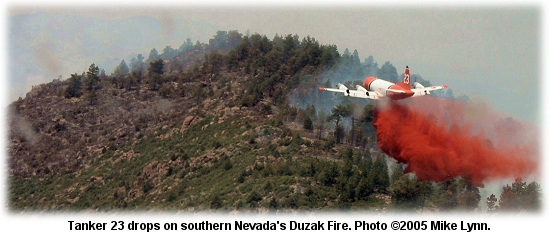
Crews are still working on patrol and monitoring, and they're mopping up hot spots within 200 feet of the fireline. They'll also rehab firelines on slopes greater than 35 percent. The BLM's Ely District will assume command of the complex tomorrow morning.

SOUTHWEST REGION AT PL4JULY 06 -- HOPE, NM: Dry weather and lightning have contributed to a number of new starts across the Southwest in the last few days, with two dozen fires reported several nights ago around Hope, New Mexico, near Alamogordo. Chad Stewart, interagency fire management officer, said lightning caused 24 fires near there Thursday night, but all were contained by midnight.
“We did staff up to prepare for it,” Stewart told the Carlsbad Current-Argus. They reported that crews had planned 8,500 acres of prescribed burning last week, but that was put on hold after a needed helicopter from Mescalero sustained minor damage from an old telegraph wire.
The Southwest Preparedness Level has been at 4 since June 23, and Texas is posting a 3.
Nationally, NIFC put the Preparedness Level at 2 on June 22. The national Multi-Agency Coordination Group (MAC) sets the PL throughout the year to assure readiness of firefighting resources. Factors such as burning conditions, fire activity, and -- especially -- resource availability are used to gauge the levels, which range from 1 to 5 (five being highest). At Level 1 there's little or no large fire activity. When one of the regions reports high fire danger with fire activity and potential for larger fires, Level 2 is declared. When two or more regions are dealing with enough fire to require a major commitment of national resources (such as hotshot crews, heavy airtankers, and Type 1 management teams) then the PL may be bumped to 3 -- but only if extra resources are being ordered through the National Interagency Coordination Center in Boise, national teams are committed in two or more regions, or 275 crews are committed nationally.
Staff at NICC explained last week that the fire situation is still well below the established crew committment of 275 -- there were just 186 crews out on July 01. Most of the fires thus far across the West have been of short duration -- two to four days -- with the exception of a few large complex fires. Containment progress has been consistent, and there's been little competition for heavy or medium helicopters, telecommunications equipment, smokejumpers, and many other national resources.
The "competition for resources" cited online on some fire-related websites has been primarily for two of the national resources -- hotshot crews and heavy airtankers. Orders for overhead have been regularly filled, with just a little sluggishness on orders for initial attack dispatchers and air attack group supervisors.
The national MAC group is assessing the situation on a daily basis.
Details on preparedness levels are available online from NIFC and from SWCC.

CAVE CREEK ALSO FIZZLESJULY 06 -- BLACK CANYON CITY, AZ: At 248,310 acres, the Cave Creek Complex in Arizona has just about fizzled out. Information Officer John Bearer told the East Valley Tribune the fire was "pretty much cold."
At 90 percent containment now, the complex has run up over $15 million in suppression costs, with 11 homes destroyed and eight injuries to firefighters. But it's almost over now.
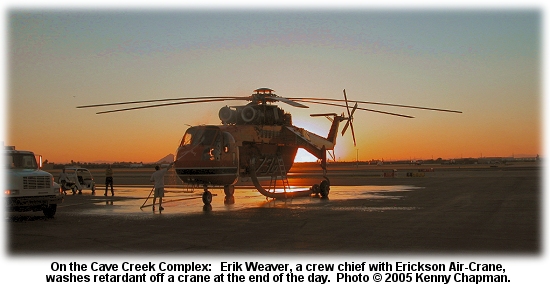
"It looks like it’s pretty well contained," said Bearer. "There’s a few hot spots here and there, but they’re pretty well inside the lines."
Resources are being demobilized from the south zone of the fire, and Philbin's Type 2 team has taken over management. On the north zone, crews are cold-trailing and mopping up with air support, and demobe's under way for excess resources. A Type 2 team will transition in tomorrow.
The entire Cave Creek Ranger District is closed, except for the Bartlett Lake area and the Mazatzal Wilderness area. The Agua Fria National Monument also remains closed for public safety.
Over the weekend, crews did burnout operations on 31 miles of the fire’s 160-mile perimeter.
Bernie Pineda, information officer, said that burnouts accounted for about 15 percent -- nearly 40,000 acres -- of the fire's total area. Pineda said everyone working the blaze was surprised it ended with such a small fight.
"The fire fizzled out on us," he said. "It didn’t want to play no more."

CALIFORNIA FIRE DOUBLES IN SIZEJULY 06 -- PALMDALE, CA: A brush fire pushed by 20 mph winds was at 300 acres last night, 550 acres this morning, and 1,200 acres by noon today. The Tovey Fire, at 75 percent containment, is southwest of Palmdale and has threatened about 100 homes. Mike McCormick with L.A. County Fire said area homeowners had done some "outstanding" brush clearing and no homes were lost.
The cause is still under investigation, according to AP reports. Dozers and hand crews are working on perimeter control.
On the San Bernardino National Forest, the Barton Fire is being handled by Kerr's Type 2 team. It's five miles east of Angelus Oaks, burning in beetle-killed timber and threatening historic properties, archaeological sites, watershed, T&E; species habitat, and some private camps and cabins. About 100 homes and two dozen commercial properties were threatened, and precautionary evacuations were ordered yesterday for 21 local camps and campgrounds and 96 historic recreational cabins. Hwy 38 was closed to non-residents for firefighter safety.
The fire was 40 percent contained at 100 acres early this morning.
The San Bernardino Sun (which has an excellent photo online) reported that more than 1,200 people were evacuated from the area. Five airtankers, two helicopters, eight hand crews, 11 engines, and a dozer are working the fire.

BLACK LINE PROTECTS BLACK CANYON CITYJULY 02 -- BLACK CANYON CITY, AZ: A major burnout has put miles of black between a small Arizona town and the fire that's been threatening it, with thousands of acres burned off yesterday ahead of the Cave Creek Complex east of Black Canyon City.
Heavy airtankers, helicopters, and SEATs painted a long line of retardant, crews built line and stripped fuels from homeowners' yards, and hotshots with drip torches combined with aerial ignition sent a wave of flames through the brush and back toward the oncoming head of the fire. The complex this morning is at 214,300 acres and 37 percent containment; resources on the fire include 28 hotshot crews, nine Type 2 crews, 17 helicopters, 73 engines, six dozers, and 15 water tenders. Almost 1,700 people are working the fire.
Contingency plans included possible closure of Interstate 17 but it hasn't been necessary yet, and fire managers don't expect any closures over the holiday weekend. The 16,000-acre burnout yesterday may be all that's needed to protect the town.
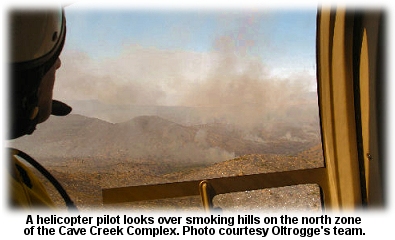 "Obviously the stakes are high," Incident Commander Jeff Whitney told the Arizona Republic. "The fire is so close right now to Black Canyon City that we have no choice. The fire has forced our hand." "Obviously the stakes are high," Incident Commander Jeff Whitney told the Arizona Republic. "The fire is so close right now to Black Canyon City that we have no choice. The fire has forced our hand."
Dick Fleishman, team information officer, said one of their priorities was to secure the northwestern corner of the fire to protect the town and powerlines, and the big burnout was probably going to do it. "That thing was a thing of beauty," he said. "It's looking really good. When you have no fuel, you have no problem."
Some photos of the burnout are online [HERE]
The East Valley Tribune reported that 11 hotshot crews worked Thursday building line east of the town. They tore into the fuels around homes in Black Canyon City, clearing chest-high brush from about 15 houses by noon.
"It’s really important to give people a little room just in case some fire was to creep over the hill," said Nic Rose, a 24-year-old firefighter with the Klamath National Forest in northern California.
Amanda Lee Myers, Tribune reporter, was impressed with the work of Rose and a couple crewmembers. "With the efficiency and speed of machines," she wrote, "the three human bulldozers removed the dry brush from around a propane tank in less than 10 minutes." Firefighters cleared chaparral from power poles and cleared dry fuels from the yards around homes.
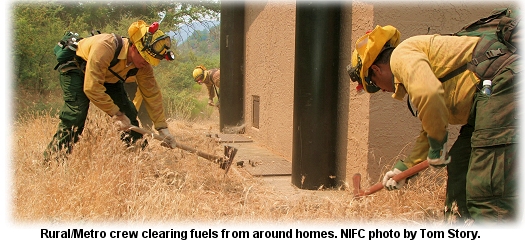
One local resident said firefighters were "working their tushes off." Another resident, Gregory Blocker, said he was grateful that the firefighters had made his home safer. "You’ve done some good work and I appreciate it," he told the crews. Amanda Dedrich, a 19-year-old firefighter from the Klamath, said that was a common response from community members. She said one resident came up and grabbed her hands and thanked her. "I just told him, ‘No problem. That’s my job.’ "

NEVADA'S FORK FIRE OVER 81,000 ACRESJULY 01 -- LAS VEGAS, NV: Suwyn's Type 2 team on the Fork Fire, 50 miles east of Las Vegas, puts containment at 87 percent this morning for the 81,700-acre fire, which is burning in piñon and grass. Better GPS mapping reduced the reported size of the fire, which yesterday was estimated at over 157,000 acres.
The fire was ignited by lightning on Tuesday, and has threatened the Lake Mead National Recreation Area, mining claim improvements, Lime Canyon and Jumbo Springs wilderness areas, Million Hills wilderness study area, communication sites, and federally protected desert tortoise habitat.
Extreme rates of spread and high flamelengths were reported yesterday at the head of the fire, but crews made good progress with firing operations along the north end of the fire. Goals include containing the fire between two forks of Lake Mead. Krugman's Type 1 team is taking over management of the fire.
The fire has contributed to a smoky haze over Las Vegas, and the Las Vegas Sun reported that the county Air Quality and Environmental Management Department issued an ozone alert Wednesday afternoon warning sensitive people to avoid strenuous exercise, especially outdoors, through Friday.

SOUTHWEST UTAH PLAGUED WITH FIREJULY 01 -- ST. GEORGE, UTAH: Firefighters attacked a new fire near St. George last night right after 10 p.m., and a day without lightning came as a relief to the 1,300+ firefighters working on fires across southern Utah. The Diamond Complex north and west of town includes the Diamond Valley, Plateau, Jarvis Peak, Wide Canyon, and Cottonwood Creek fires. The complex is 50 percent contained at 10,500 acres.
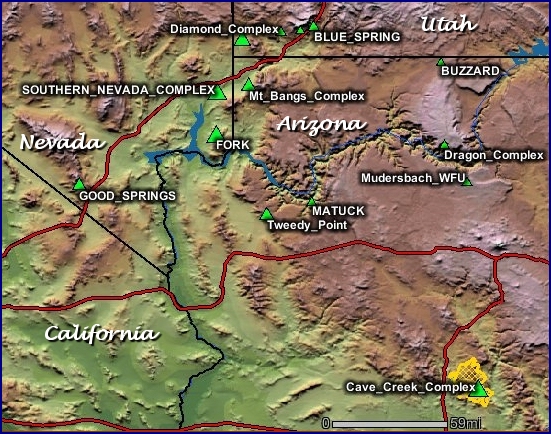
The Spectrum reported that both the Jarvis Peak Fire and the Plateau Fire were contained.
More than 1,200 residents were without power Wednesday night because of the fires. The Cottonwood Creek Fire west of the Diamond Valley Fire has burned 324 acres and is being evaluated because of its proximity to the Diamond Valley Fire. The 12,280-acre Blue Springs Fire, 30 miles northeast of St. George, is 70 percent contained.
The Duvac Fire, part of the South Desert Complex in Nevada, has crossed the border and burned 22,210 acres in Utah. The 529-acre Harrisburg Fire northeast of St. George is 80 percent contained. The Mt. Bangs Complex south of Mesquite is 80 percent contained at 30,153 acres. The Buzzard Fire east of Fredonia is at 600 acres.
The Tweedy Point Fire has burned more than 39,000 acres south of the Utah state line in the Grand Canyon Parashant National Monument. It's 20 percent contained, burning in heavy cheatgrass, sagebrush, piñon, juniper, and desert scrub. Rohrer's Type 3 team transitioned with Thomas's Type 2 team this morning.

CAVE CREEK COMPLEX CHALLENGES RODEO-CHEDISKI FOR STATE'S LARGEST FIRE IN HISTORYJUNE 29 -- CAMP VERDE, AZ: Arizona's second largest fire in history was up to 172,800 acres today, continuing its run north into the Rim Country and worrying residents of small towns north of the fast-moving fire. Crews on the north division hope to keep the fire from crossing the Verde River and threatening the communities of Pine and Strawberry and areas around Black Canyon City and Camp Verde. But the fire today -- with the south zone at 40 percent containment and the north zone at zero percent containment -- was just 12 miles from the trigger point that will start evacuations.
Burnout operations are planned on the north zone to keep the fire east of Black Canyon City, which will probably close Interstate 17 again. When and how the fire spreads west will determine the timing of any closures.
Aerial firing is also being considered in some areas.
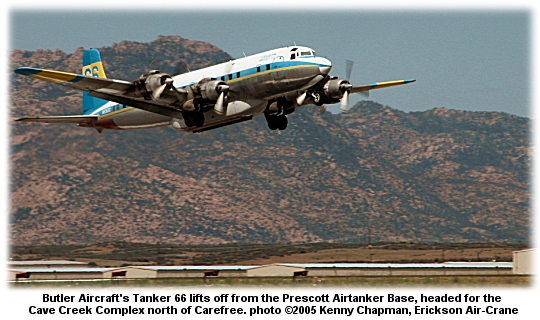
The ponderosa pines in the area around Pine and Strawberry (the largest continuous stand of ponderosa pine in the world) have been hard hit by beetle kill in a long-running drought, and are vulnerable to a fast-running fire. And the Cave Creek might just be the fire to overtake the record-holding 2002 Rodeo-Chediski, which at 462,159 acres burned its way into history as the largest wildfire ever in Arizona.
Last year's 119,500-acre Willow Fire burned near Payson for weeks, and according to AP reports, it was the second-largest fire in Arizona history until the Cave Creek Complex fire surpassed it this week.
The Southwest Area MAC group tonight ranked the Cave Creek Complex second on its priority list, right after local initial attack (a typical standard). According to MAC group coordinator Dave Cummings, they'll have another conference call about prioritizing resources for regional fires on Friday. Resources on the fire include 27 hotshot crews from at least six states, along with a half dozen Type 2 crews, 32 engines, four dozers, and eight helicopters. The fire's been repeatedly hit by heavy airtankers flying from the tanker base at Prescott.

The threat to the Pinnacle Peak powerline is now confined to the northern portion of the fire. Shifting winds, steep slopes, rapid spread, and poor access have frustrated containment efforts, and the fire has burned into the New River Mountains.
One of the two Type 1 teams managing the complex, Oltrogge's team has established an ICP in Camp Verde after taking over the northern division, which covers nearly 5,800 acres and currently threatens 4,000 homes and about 50 commercial properties. A joint information center's also been established in Camp Verde. KVOA-TV reported today that dozens of residents at a community meeting last night in Camp Verde were reassured by Incident Commander Dan Oltrogge that he estimates the fire's chances of jumping the Verde River at just 25 percent.
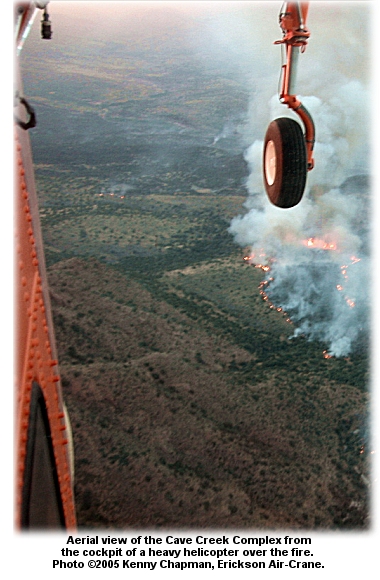 But it could happen, and fire managers know it. Chris Lyle, planning section chief on the fire, told the Arizona Republic it's happened before. But it could happen, and fire managers know it. Chris Lyle, planning section chief on the fire, told the Arizona Republic it's happened before.
"I hate to say it," he said, "but the stars are lined up. And that's what happened with the Rodeo-Chediski." Lyle said they don't want to scare people, but the fire's spread is unpredictable. "We don't know where the winds will be pushing the fire from hour to hour."
Two more community meetings were scheduled this evening, one at the High Desert Park in Black Canyon City and one at the community center in Pine.
The Arizona Republic reported tonight that nearly 400 people showed up for the community meeting in Pine. Payson District Ranger Ed Armenta said the national forest around Pine and Strawberry would remain open to the public for the holiday weekend.
KPHO-TV reported that more than 200 people packed the park in Black Canyon City this evening to hear what fire managers had to say. They were told that plans include several days of back-burning and cutting line with dozers east of the community. The incident management team is working with the Arizona Department of Transportation on plans for the Fourth of July weekend.
The fire is now about seven miles east of Black Canyon City, and from there a wall of smoke is visible.
Assessment of threats to homes in Camp Verde is under way, and structure protection is being completed at the Childs Power Plant out by Fossil Creek. Six helicopters and about 40 engines are assigned to the northern division of the fire, with 17 crews including 13 hotshot crews.
Crews worked today on improving firelines on the west side of the New River Mountains. The fire was backing down toward the lines, and could be clearly seen from the I-17 corridor in many locations. As of this evening, though, it was still holding west of the Verde River.
Traffic in and out of Camp Verde was slowed this morning, according to the East Valley Tribune, when a small brush fire in the median on Interstate 17 just south of Camp Verde caused the closure of the inside lanes on both sides of the freeway.

HOT TIMES AT CEDAR CITYJUNE 29 -- CEDAR CITY, UTAH: The tanker base at Cedar City has been a busy place the last week or so, with airtankers flying in and out on a shifting list of fires around the region. David Ricks, assistant retardant manager at the base, told the Salt Lake Tribune he's been loading tankers more than 60 times a day.
Most of the runs this week have been on the Blue Spring Fire, burning on the Dixie National Forest adjacent to Interstate 15. The fire evacuated most of the town of New Harmony Monday night, and has repeatedly closed the highway.
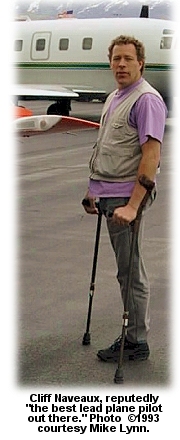 The fire last night was 50 percent contained at 12,260 acres. The fire last night was 50 percent contained at 12,260 acres.
Tankers out of Cedar City also worked the Red Fire and West Side Complex.
The 10,000-gallon retardant tanks are refilled six times daily from tanker trucks. "I use about 122,000 gallons of retardant a day," said Ricks. Five heavy airtankers have been flying out of Cedar City, along with six SEATs, three helicopters, and lead planes.
Cliff Naveaux, a lead plane pilot, has worked 32 years in fire, and flown a lead plane for the last 18 years. He was a smokejumper, but began flying after he lost a leg in 1987 in an avalanche accident.
"At the time I lost my leg I had some aviation experience and wanted to stay in fire," he said. Based in New Mexico, Naveaux flies a twin-engine King Air for the BLM.
All available heavy tankers have been flying lately, mostly in the Southwest, and more will come on contract in the next few weeks.
Naveaux says the pilots have been busy. "You want to lay the retardant faster than the fire is burning," he said. "If you can't out-gun the fire, then you are playing catch-up."

BLUE SPRING FIRE EVACUATES
UTAH TOWN, CLOSES FREEWAYJUNE 28 -- NEW HARMONY, UTAH: Fresh crews rolled into town today to relieve crews that had worked through most of the night to protect the town of New Harmony from the 12,260-acre Blue Spring Fire. Muir's Type 2 team puts the fire tonight at 50 percent containment.
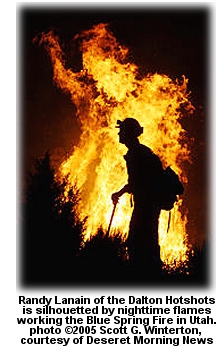 The Deseret News reported that five airtankers were on the fire yesterday. The Deseret News reported that five airtankers were on the fire yesterday.
Good progress was made on the fire today, with crews helped out by a little precipitation, cooler weather, and lighter winds. Fire managers said local initial attack crews were supported by air resources, with over 760 personnel on the fire tonight.
Most of New Harmony, about 30 miles northwest of St. George in Utah's southwest corner, was evacuated last night, with about 100 residents leaving 27 homes. The evacuation orders for Harmony Heights were lifted this evening.
Firefighters yesterday worked in the neighborhoods past midnight, drawing water from a local reservoir. David Boyd, team information officer, said airtankers dropped on the fire till dark. "It played a significant role in protecting the homes," said Boyd.
He said four helicopters also worked the fire; they worked the fire all day, and one of the heavies stayed on till about 9 p.m. with a number of engines and hotshot crews on the ground.
Muir said the fire was was pushed by high winds and running hot yesterday evening, burning northward six miles in just two hours. Some residents were at a community fire meeting last night when they were told to go home and evacuate immediately.
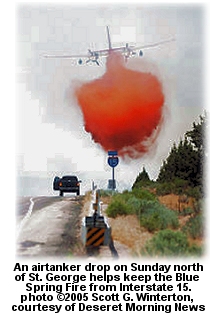 The fire burned an 8-mile stretch along Interstate 15, causing intermittent closures for the safety of travelers and firefighters. The fire burned an 8-mile stretch along Interstate 15, causing intermittent closures for the safety of travelers and firefighters.
Burning on Dixie National Forest land on the west side of I-15, the fire forced the Utah Highway Patrol to close down the freeway in both directions several times on Sunday. Airtankers dropped retardant along the fire perimeter to keep it from jumping the highway.
Several large powerlines were burned, but power had already been diverted.
An early morning lightning storm started two new wildfires in the area. The town of Motoqua, a cluster of 12 homes about 25 miles west of St. George, was put under a one-hour evacuation order as flames moved to within 1½ miles of the town.

ARIZONA FIRE WEATHER: HEADS UP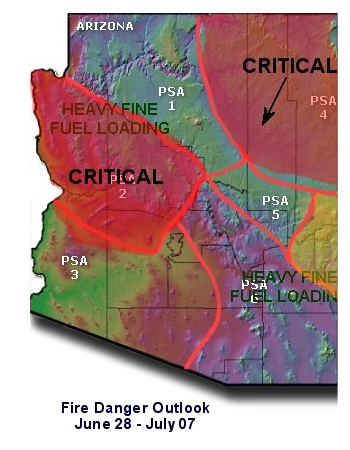 JUNE 28 -- FLAGSTAFF, AZ: The Moqui Lookout on the Coconino National Forest this afternoon reported southwest winds of 30 to 40 mph with gusts of 80 mph. JUNE 28 -- FLAGSTAFF, AZ: The Moqui Lookout on the Coconino National Forest this afternoon reported southwest winds of 30 to 40 mph with gusts of 80 mph.
There's a red flag warning in effect today for western and northern Arizona for strong southwest winds and low humidity, according to fire weather specialists at the Southwest Area Coordination Center, with scattered dry thunderstorms across the northern and eastern parts of the state.
Fire meteorologists are predicting a strong drying trend for the rest of the week, with lowering humidity, warming temperatures, increasingly poor nighttime recovery, and gusty afternoon winds.
Very active to extreme fire behavior should be expected in brush and grass areas and into the pine belt; extreme fire behavior is possible on slopes and has been observed on recent fires in chaparral.
Long-distance and profuse spotting has been reported from the Cave Creek Complex, and firewhirls are a concern on flanks of fires.

CAVE CREEK ACRES UP, SECOND TEAM ONJUNE 28 -- CAREFREE, AZ: On the Cave Creek Complex on the Tonto National Forest, Whitney's Type 1 team is managing Zone 1 and Oltrogge's team took over Zone 2 today. The fire burned into Red Creek Drainage, which was a trigger point for activating a second IMT.
The complex includes the Lousy, Broad, and Cave Creek fires northeast of Carefree, Arizona. The fire, burning in chaparral, oak, and grass, is threatening a major power grid, riparian areas, endangered species habitat, and archaeological resources. Steep slopes, extreme fire behavior, flashy fuels, and poor access are proving difficult.
About 250 homes have been evacuated.
Firefighters today are expecting flamelengths up to 30 feet, with plume-dominated fire behavior. The south side of the fire is secure, but crews have been spiked out northwest of the fire to allow for better access.
Yesterday the fire crossed into the Red Creek drainage and burned into the Upper Ranch area. This morning it was 25 percent contained at 124,033 acres. Four injuries have been reported, and 11 homes were destroyed. The fire's threatening the LX Bar Ranch, the Tangle Creek administrative site, the Red Cross Ranch and Upper Ranch, and the Copper Creek administrative site. Whitney's team reports that the fire's been following the path of the Pinnacle Peak 345 KV powerline, which is a critical element of the power grid and provides power from Glen Canyon to Phoenix.
The Western Area Power Administration and the IMT may decide to de-energize the powerline to ensure the safety of firefighters working under it. This is not expected to disrupt service to the Phoenix area.
Fire activity intensified significantly Sunday afternoon, with extreme fire behavior, and the fire burned across the Bloody Basin Road -- the last reasonable control feature before the Pine Mountain Wilderness. "That was our defense line, but it just kept going and going," planning section chief Chris Lyle told the Arizona Republic. "But if you can't catch it, you basically have to back out and decide where it's going to go next."
The East Valley Tribune reported that the second team was ordered because of concerns that the fire could threaten Rim Country communities including Dugas, Pine, and Strawberry; ash has been falling around both Pine and Strawberry. The Pine-Strawberry Fire Department hasn't yet decided on evacuation plans. The fire's expected to reach the Mogollon or Verde Rim in about three days. Back-country roads on the Prescott and Coconino national forests have been closed, a voluntary evacuation was put in place for the Childs Recreation Area along the Verde River, and the Coconino has closed access to Fossil Creek, Irving, and Childs.
A community meeting is scheduled at Camp Verde at 6 p.m. this evening at the Camp Verde High School and another will be held tomorrow at 6 p.m. in Pine at the Pine Cultural Center.
More than 800 people are working on the fire. Resources include more than two dozen hotshot crews and nine Type 2 crews, 28 engines, four dozers, and a dozen helicopters -- four lights, four mediums, and four heavies.
The world's largest saguaro (see 2003 photo), a 46-foot cactus near Horseshoe Lake, was scorched by the fire and is not expected to survive.

SOUTHWEST AND NATIONAL
PREPAREDNESS LEVELS BUMPED UPJUNE 24 -- BOISE, IDAHO: The National Interagency Coordination Center has raised the National Preparedness Level to 2 because of burning conditions, fire activity, and resource availability; several regions have posted high to extreme fire danger, activity is increasing, and several regions have large fires burning.
The Southwest region is at PL4 -- with nine large fires active. Nationally, 232 new fires were reported yesterday; 11 were large (over 100 acres) -- four in the Southwest, five in the Western Great Basin, and two in the Eastern Great Basin.
The Southwest has two Type 1 teams activated; Whitney's team is on the Cave Creek Complex [photos] northeast of Carefree, Arizona, and Oltrogge's team is handling the Humbug Fire south of Crown King, Arizona. The AP reported that the Cave Creek Complex evacuated about 250 homes in Tonto Hills. Some residents decided to leave when tankers dropped retardant on their neighbor's deck.
The Cave Creek Complex is 5 percent contained at 46,000 acres, and the Humbug is zero percent contained at 1,500 acres. The Humbug is threatening the small mining town of Crown King. The BIA's San Carlos Agency reported a new fire overnight; the 2,000-acre Saddle Mountain Fire. Other recent starts include the Lousy Canyon Fire at 500 acres northeast of Black Canyon City, Arizona, the 200-acres Big Horn Fire northwest of Buckeye, Arizona, and the 75-acre Chewie Fire west of Bagdad, Arizona. The Jane Fire (previously referred to as the Gladden Fire), was 80 percent contained Thursday evening.
The Three Fire on the Tonto northwest of Tonto Basin, Arizona, is zero percent contained at 11,000 acres. Philbin's Type 2 team is assigned.
All teams and all crews in the Southwest are now committed, except for the Silver City Hotshots on a mandatory day off.
In the Western Great Basin, a Type 1 team's been ordered for the 15,000-acre Goodsprings Fire northwest of Jean, Nevada. It's zero percent contained and mandatory evacuations for the Mt. Potosi area and a boy scout camp are in effect. Tankers 48 and 44 were both flying the fire out of Cedar City this morning. The Las Vegas Review-Journal reported that the Goodsprings Fire was burning creosote bushes, Joshua trees, and other desert shrubs; it's reportedly the largest southern Nevada fire in several years, and the largest of 32 lightning-ignited fires in the area.
The region's got eight other fires burning: the 10,000-acre Southern Nevada Fire, the 7,000-acre Meadow Fire, the 7,000-acre Halfway Fire, the 5,000-acre Dodge Pocket Fire, the 5,500-acre Toquop Fire, the 3,800-acre Coyote Fire, and the 300-acre Tule Fire. Containment on all fires ranges from zero to ten percent. The Badger Fire was contained at 736 acres.
Southern California's got three active large fires under way. The 21,200-acre Hackberry Fire at Mohave National Park is threatening the Seven IL Ranch, Mid-Hills campground, historical sites, archaeological sites, and wildlife habitat. Round Valley was evacuated; the fire's 10 percent contained. The Paradise Fire southwest of Morongo Valley is 50 percent contained at 3,022 acres and the Soboba Fire north of San Jacinto is 50 percent contained at 2,080 acres.
An AP report in the San Diego Union-Tribune said the Paradise Fire destroyed at least six homes, threatened hundreds of others, and forced evacuations.
The Eastern Great Basin's Red Fire northwest of St. George, Utah, is 75 percent contained at 8,300 acres. The region reported five other fires contained, ranging from 500 to 2,300 acres.
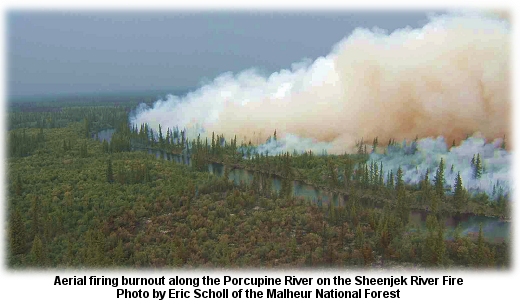
Alaska reports three large fires -- the 68,480-acre Sheenjek River Fire is at 40 percent containment, the Chapman Creek Fire is still zero percent contained at 48,000 acres, and the Billy Hawk Creek Fire is 85 percent contained at 2,000 acres.
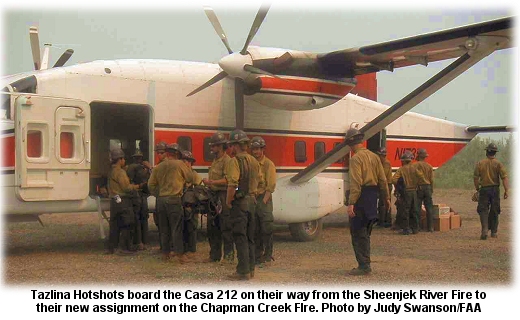
Crews held and increased the firelines on the Sheenjek River Fire yesterday; five helicopters, two CL-215 scoopers, and one of Aero Union's P-3s worked on hot spots and new burnout areas northeast of Fort Yukon. One hotshot crew was reassigned to another priority fire, and two replacement hotshot crews were ordered.

S-2T FLIES OUT OF CHICOJUNE 24 -- CHICO, CA: A visiting CDF airtanker was put to work yesterday out of Chico, and the tanker base is still waiting for its assigned tanker for the season. Pilot Walt Darran took the Grumman Aerospace S-2T up for a drop on a grass fire east of town.
Darran told the Enterprise-Record that the tanker is faster and more maneuverable than the S-2A he flew last year. He flew the S-2A when he became a pilot in 1973, and said he was the first Chico pilot to fly an S-2T on a fire in the north state.
Darran dropped 1,000 gallons of retardant on yesterday's grass fire; the S-2T can carry 1,200 gallons.

BLAZING ARIZONAJUNE 22 -- FORT HUACHUCA, AZ: It's fire season in Arizona, with new smokes and big fires from one end of the state to the other today.
The Southwest Area Coordination Center (SWCC) started out the morning with a report from the Tonto National Forest: firefighters there were working a number of fires including two fires in Cave Creek (the Bronco and Humbolt Fires), three fires in Tonto Basin (one at 1,000 acres), and three fires on the Payson Ranger District (two in wilderness areas and one in Deadman Mesa).
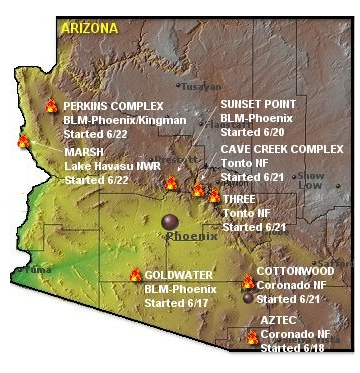 By 8:30 a.m. Reinarz's Type 2 team had been assigned to the Goldwater Fire and the BLM had reported a number of fires in northeast Arizona. The Silver Creek Fire was at 200 acres and the Perkins Complex of eight fires had put in orders for two airtankers, two helicopters, and a lead plane. The State was also working a number of fires, including the 30-acre Bronco Fire on the Tonto. By 8:30 a.m. Reinarz's Type 2 team had been assigned to the Goldwater Fire and the BLM had reported a number of fires in northeast Arizona. The Silver Creek Fire was at 200 acres and the Perkins Complex of eight fires had put in orders for two airtankers, two helicopters, and a lead plane. The State was also working a number of fires, including the 30-acre Bronco Fire on the Tonto.
Within an hour, personnel on the Humbolt Fire reported it at 80 acres; firefighters were pulled off the line late yesterday for safety reasons. The 1,100-acre 3-Fire was reported in the Four Peaks area, and the Deadman Fire in Fossil Creek (locally known as Panty Creek) was at 20 acres. The Cedar Fire was at 80 acres, and the Bench Fire also at 80 acres.
At 11:30 a.m. it was determined that the regional MAC Group will confer this evening.
Before noon, SWCC reported that the Humbolt Fire had jumped a road into the Red Rover area, with powerlines affected and possible structures threatened. The Coronado National Forest reported a new fire on Mt. Lemmon, the Cottonwood Fire, and an airtanker and lead plane were ordered. The Tonto reported four airtankers (heavies and SEATs) and a lead and four helicopters committed on initial attack.
And that was just the morning for the coordination center.
Early in the afternoon the Cottonwood Fire, at 30+ acres, requested three airtanker drops. The Goldwater Fire was also requesting tanker drops.
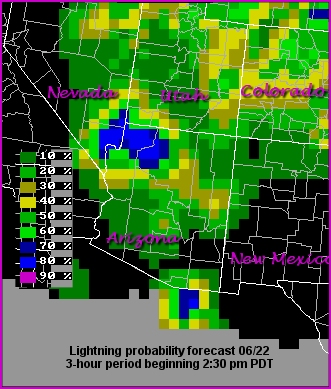 Half of the Southwest area incident management teams are committed, and every single one of the region's Type 1 crews are committed. There are also seven hotshot crews from out of the region working on fires in the Southwest: Midewin from the Eastern Area, Bonneville and Logan from the Eastern Great Basin, Pike from the Rocky Mountain region, and the Dalton, Vista Grande, and Laguna 'shots from Southern California. Half of the Southwest area incident management teams are committed, and every single one of the region's Type 1 crews are committed. There are also seven hotshot crews from out of the region working on fires in the Southwest: Midewin from the Eastern Area, Bonneville and Logan from the Eastern Great Basin, Pike from the Rocky Mountain region, and the Dalton, Vista Grande, and Laguna 'shots from Southern California.
And then there's weather. Thunderstorms were forecast all across the Southwest for today, mainly at higher elevations, with sustained winds up to 15 mph but gusting to 40 mph in the vicinity of thunderstorms. Firefighters were cautioned this morning that active to very active fire behavior was possible in brushy and grassy areas and into the pine belt below 8,000 feet, and thunderstorms could cause downdrafts that might produce high winds. The probability of lightning storms across northwest Arizona early this afternoon was 70 or 80 percent.
Whitney's Type 1 team was assigned this afternoon to the Cave Creek Complex, which includes the Humbolt Fire (over 1,000 acres), the Bronco Fire (30+ acres), and several other smaller fires.

RED FLAG ON THE SHEENJEK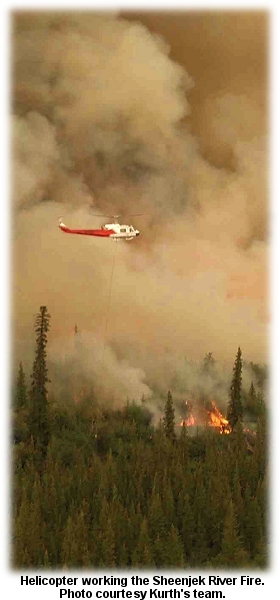 JUNE 22 -- FORT YUKON, ALASKA: The National Weather Service issued a Red Flag Warning in effect from 10 a.m. today until 10 p.m. tonight, with predicted northeast winds of 15 to 25 mph and gusts up to 35 mph near Fort Yukon. The Sheenjek River Fire, 15 percent contained at 64,000 acres, had winds picking up overnight and gusting up to 20 mph after midnight. JUNE 22 -- FORT YUKON, ALASKA: The National Weather Service issued a Red Flag Warning in effect from 10 a.m. today until 10 p.m. tonight, with predicted northeast winds of 15 to 25 mph and gusts up to 35 mph near Fort Yukon. The Sheenjek River Fire, 15 percent contained at 64,000 acres, had winds picking up overnight and gusting up to 20 mph after midnight.
Information Officer Tom Kempton on Kurth's Type 2 team said firefighters yesterday doubled their efforts to secure the fireline that was burned out earlier at the head of the fire. Helicopters dropped incendiary ping-pong balls from an island on the north side of the Porcupine River toward an area that was burned by the Winter Trail Fire last year; it's planned that this line will keep the fire north of the river as winds shift today.
Crews built a new helispot north of the head of the fire, and firefighters will be flown in today to work on keeping the fire from burning west. Firefighters will also work on protecting cabins along the river and improving helispots.
CL-215 scoopers out of Fairbanks reinforced the line that was fired out earlier; the first two worked several hours before returning to Fairbanks to refuel. Two more were requested, according to Kempton, but were unavailable, so operations continued with helicopters and bucket work.
Other resources on the fire include five Type 1 crews and four Type 2 crews, 14 boats and five helicopters.

WILDFIRES FEATURED ON STORM STORIES TONIGHTJUNE 21 -- SAN DIEGO, CA: In southern California in the fall, when the Santa Anas begin, residents and firefighters know that wildfires will soon follow. A high-pressure system parks over the region and causes cold, dense air to spin clockwise, moving toward the southwest and eventually slamming into the mountain ranges.
The Weather Channel's STORM STORIES will feature this week a special on the 2003 California fires. It will air tonight at 8 p.m. (EDT and PDT). Check your local listings for details.
Interviews include Division Chiefs Andy Paar and Ken Kremensky of the Lakeside Fire District, and an overview of the Cedar Fire, the largest fire in California history.
The Cedar Fire killed 15 people and destroyed more than 2,000 homes. It took off after a lost hunter on the Cleveland National Forest set a fire in hopes of attracting rescuers. In a deal with federal prosecutors, Sergio Martinez pleaded guilty to one count of starting the fire.
 Also this week, the Weather Channel will air two new 30-minute episodes on the Forecast Earth series, called "Mega Fires" and "Battling Mega Fires." Also this week, the Weather Channel will air two new 30-minute episodes on the Forecast Earth series, called "Mega Fires" and "Battling Mega Fires."
They're scheduled for Wednesday between 9 and 10 p.m. EDT, Thursday between noon and 1 p.m. EDT, Friday between 7 and 8 p.m. EDT, and Saturday between 1 and 2 p.m. EDT. These episodes will look at the conditions that set the stage for a huge fire, and the people and operations employed in fighting them.

SHEENJEK RIVER FIRE NEARS 60,000 ACRESJUNE 21 -- FORT YUKON, ALASKA: Eight miles northeast of Fort Yukon, the lightning-caused Sheenjek River Fire has reached 59,572 acres.
Kurth's Type 2 team reports it at 15 percent containment with 20 miles of line yet to build. 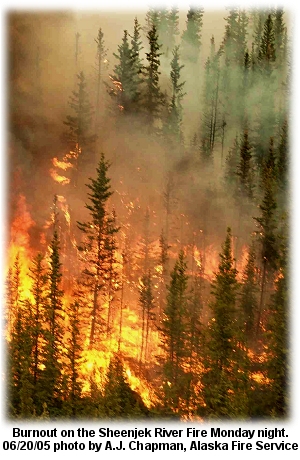 Almost 300 personnel are assigned to the fire, and Kurth's team reported that CL-215 air support is essential to meeting their containment objectives. Almost 300 personnel are assigned to the fire, and Kurth's team reported that CL-215 air support is essential to meeting their containment objectives.
The Fairbanks News-Miner reported that two of the four CL-215 tankers ordered for the fire were diverted to the Chapman Creek Fire south of Coldfoot.
Information officer Kris Eriksen said the two remaining scoopers were mostly hitting the head of the fire on the west line, which is closest to Fort Yukon. With the scoopers making water drops, the helicopters were hitting hot spots on the eastern and southern perimeters and assisting with reinforceing the burnout done on the western edge. They also helped ferry firefighters and equipment.
Crews on the south and east perimeters are conducting burnouts, and are keeping an eye on the wind.
"You can tell the winds have shifted," said Eriksen, "because there's smoke over camp and the town has this strange yellow glow and particles of ash are falling."
The fire had threatened cabins and allotments in the area, but they've been protected.
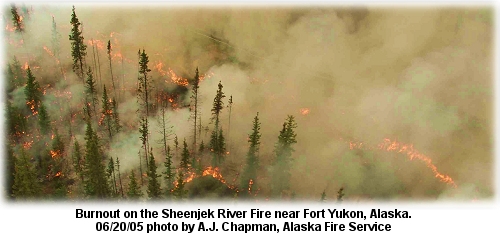
Firefighters report the fire's burning in birch, aspen, black spruce, and white spruce, with torching and crowning in the spruce. The fire's made runs in the hardwoods and brush, and yesterday spotted across the Porcupine River.
Temperatures have been in the low to mid-70s, with light winds of 5 to 10 mph expected.
The Chapman Creek Fire is estimated at 21,500 acres, having grown from 100 acres since it was first spotted May 30. Two smokejumper crews were deployed on Monday, with two Type 2 crews scheduled to arrive today.

ARIZONA FIRE CLOSES FREEWAYJUNE 21 -- CORDES JUNCTION, AZ: Both lanes of Interstate 17 near Prescott were closed today, with six hotshot crews and a couple of heavy airtankers working to contain a 4,500-acre fire near the freeway. The Sunset Point Fire started yesterday afternoon north of Black Canyon City, and grew to more than 1,000 acres overnight. Carrie Templin with the BLM told the Arizona Republic it was at 40 percent containment earlier today.
Walker's team said they hope to have it contained by Thursday evening.
They cited safety issues because of the fire's proximity to the freeway, along with issues posed by open range livestock in the area. The fire has moved into the Agua-Fria river canyon, into extremely steep and rocky terrain. Temperatures over 100º with single-digit RH are also a problem; 15 mph winds are expected today, with temperatures over 110º and low humidity. Firefighters reported rapid rates of spread with heavy fuel loading and erratic shifting winds that pushed the fire through tall grass.
Northbound I-17 lanes were closed at about 2:30 a.m. near Black Canyon City, and the southbound lanes were closed at 7 a.m. The southbound lanes were re-opened this afternoon.
The fire burned across the mesa and blew south into Black Canyon; it was already active early this morning and fire managers reported SEATs up and flying. Philbin's Type 2 team will take over tonight.
Two helicopters -- one light and one heavy -- have been working the fire, and Tankers 21 and 22 dropped on it yesterday afternoon and were flying again this morning. Other resources included a dozen engines and three water tenders.
NOTE: azcentral.com has video online, opening with a drop by T-22, and the first part of the clip is worth watching. Users must allow cookies by the website to view the video. The website also notes that they must be able to "resize your broswer" (sic) so if you have trouble viewing the video you'll have to change that, too.
Another fire south of Gila Bend on the Barry Goldwater Air Force Range is at 15,000 acres with zero containment. The Goldwater Fire is threatening powerlines that supply the towns of Ajo and Why, along with endangered species habitat. The fire's burning in grass and brush; it jumped Highway 85 yesterday and has burned several power poles.
Daniels's team reported that lack of contact and guidance from the military on objectives and concerns has been an issue. Formerly the Luke Air Force Range, the Barry Goldwater Range serves both the Air Force and Marine Corps as an armament and high-hazard testing area, a training area for aerial gunnery, rocketry, electronic warfare, and tactical maneuvering and air support. It also serves "other defense-related purposes."
On the Coronado National Forest, the 1,300-acre Aztec Fire is 40 percent contained. Raley's team reported last night that the fire's threatened 20 homes and about 20 other buildings. There are 460 personnel assigned.

CALIFORNIA FIRE THREATENS 250 HOMESJUNE 19 -- YUCCA VALLEY, CA: A brush fire that started about 4:30 yesterday afternoon in San Bernardino County caused many residents to leave Pioneertown on a voluntary evacuation. Dispatchers reported helicopters and airtankers working the fire, with more on order.
An AP report put the fire at 500 acres last night, with more than 180 firefighters assigned. By midnight the Pioneer Fire had grown to 1,000 acres and was reported at 10 percent containment; there were 380 firefighters assigned, mostly from CDF and the Forest Service. Steep terrain and high winds contributed to the growth of the fire, which was burning in grass, sage, and juniper and threatening the Pipes Canyon Preserve, a 15,000-acre private nature preserve in the high desert near Joshua Tree National Park.
Firefighters reported that the fire laid down some during the night, but winds are expected to increase again today.

PILOTS MEMORIALIZED IN NEVADA ON ANNIVERSARYJUNE 17 -- MINDEN, NV: Three years after their C-130 airtanker went down on a fire near Walker, California, Steve Wass, Craig LaBare, and Mike Davis were remembered today with a solemn ceremony at the airport where they were based.
"Just as the 2005 fire season is beginning, we recall that they gave their all in 2002," said Russ Bird, aviation manager for the Sierra Front Interagency Dispatch Center at the Minden-Tahoe airport. "We need to remember what the risks are. The forest is important, but life is always the most important to us."
The Las Vegas Sun reported that Mike Lynn, who flew with Wass and had previously piloted the tanker, attended the ceremony.
"We're a very small family, closely knit," he said. "Things like this mean a lot to us."
Previous memorials were established near the site of the crash at Walker and in a park in Minden. The new plaque established at the Minden airport today lists the names of the men on the plane, followed by the phrase, "Go West." Lynn said tanker pilots see going west -- toward the setting sun -- as heading home after a long day.
At a memorial service for Wass three years ago, fellow Minden pilot Brian Bruns did a flyover in an airtanker, veering off to the west. He was one of three who were killed in April on a training flight north of Chico, California.

FAIRBANKS HAZY FROM ALASKA FIRESJUNE 16 -- FAIRBANKS, ALASKA: Drifting smoke from wildfires northeast of Fairbanks cast a haze over the Tanana Valley yesterday; Aaron Tyburski, a meteorologist at the National Weather Service in Fairbanks, told the Fairbanks News-Miner that the smoke level was up at 8,000 or 10,000 feet.
"We see it as more of a haze than the choking smoke we had last year," he said.
The 8,345-acre Chapman Creek Fire is more than 200 miles north of Fairbanks, and the 7,927-acre Sheenjek River Fire is northeast of Fort Yukon. They're the largest of the more than 50 active fires in Alaska. A Type 2 team is taking over the Sheenjek River Fire today, and Aero Union's Tanker 27 was headed toward Alaska from Chico this morning.
The Alaska Fire Service reported yesterday that the Sheenjek River Fire has two hotshot crews and three Type 2 crews, with more hotshots and emergency firefighter crews coming in. Crews are working on structure protection and burnouts to protect cabins and allotments, and the CL-215 scoopers have reportedly been very effective. The Chena Hotshots were working on the Dosennaughten Lake Fire southwest of Bettles but were expecting to head for the Sheenjek River Fire.
Some 20 new fires were reported in the Interior on Tuesday and Wednesday, most of them lightning-caused. The National Weather Service said thunderstorms caused more than 12,000 lightning strikes in the Interior last weekend; state forestry officials discovered a 500-acre fire near Monson Creek about 20 miles south of Chena Hot Springs Road during a fly-over yesterday. Robert Schmoll, fire management officer for the Division of Forestry in Fairbanks, said it's in a limited suppression area near where a fire burned about 20 years ago.
So far this year the Alaska Interagency Coordination Center reports that 235 fires statewide have burned 46,089 acres.

PILOTS WITH "ISSUES" CANNED BY USFSJUNE 10 -- PRESCOTT, AZ: The U.S. Forest Service recently determined that contract pilots flying heavy airtankers needed to pass background investigations, and several of the pilots have been effectively grounded because of "issues" with those investigations.
Forest Service helicopter pilots -- some of whom are not even U.S. citizens -- and BLM pilots are not being subjected to the background investigations, which are being conducted by the federal Office of Personnel Management.
Several of the airtanker pilots who have been forbidden to fly have military backgrounds, and some have flown on fires for more than 20 years.
Sidelining pilots is creating havoc with tanker assignments, even early in the season with less than half the airtankers on duty. "Three pilots from Aero Union were told to stay away from the airplanes," said one pilot. "Two others I know are getting the same runaround, and no reason for their rejection was given." One of the pilots who's still okayed to fly is filling in for a pilot who was canned, but he's supposed to be starting his tour with his own tanker soon.
"It's pretty amazing that they can pull us off the line on an assumption," says Steven Maxwell, one of the pilots now on the bench. "The background check isn't even completed."
Del Hunt, another blacklisted pilot, has contacted a lawyer about the issue. " I have flown tankers as captain in excess of twenty years," says Hunt. "I am crushed at losing my job -- I obey the laws of the land! I have done nothing to deserve this."
Former tanker pilot Terry Johnson said he's known Hunt for about twenty years. "I never saw him do anything unAmerican," said Johnson. "Goofy on occasion, but never anti-social."
Greg Rowe, who flies for -- or flew for -- Butler Aircraft in Oregon, said he turned in his Form 85P "Questionnaire for Public Trust Positions" background check forms to the Forest Service in April. "On May 17 Butler was notified by our contracting officer that I had 'issues' with my background check and was not qualified for the contract until the 'issues' were resolved," said Rowe. He says he doesn't have a single thing on his record that should make him ineligible to fly. "I've got excellent credit. My student loans are paid. I have no criminal history. No drug or alcohol related charges. No unpaid speeding tickets. I pay my taxes. I love Mom, apple pie, and baseball and I've just lost my job because of this background check."
The questionnaire for his background check covered the last seven years -- the last five of which he's flown airtankers, after two years as a college student working summers for the Forest Service at an airtanker base.
Rowe says he's tried and failed to get answers on what his "issues" might be. "They will not disclose ANY information to me, or allow me to assist in resolving my 'issues' in any way," said Rowe. He said he faxed a letter requesting the status of his backgound check and received a response that his background check was "still pending."
As many as eight pilots have been removed from service.
The Office of Personnel Management (OPM) website says that part of the agency's mission is to conduct National Security Investigations on individuals who work in positions that require access to classified information. "OPM conducts background investigations for most federal agencies and their contractors." The OPM has a contract workforce of more than 3,000 field investigators and more than 150 federal staff to oversee their work and develop policy.
The OPM's FAQ page includes this: How can I see the report you prepare about me? and the answer is:
The only persons authorized to see this information are Personnel Security, Suitability, and Investigations professionals who have been investigated and have a demonstrated need to review the information. You may request a copy of your investigation file under provisions of the Privacy Act. For an OPM investigation request, write to OPM-CIS, FOIP, Post Office Box 618, Boyers, PA 16018-0618. You must include your full name, Social Security Number, and date and place of birth, and you must sign your request.
The 11-page OPM 85-P form, by the way, is online in PDF format if you'd like to see what the pilots had to submit.

LEAVING CEDAR CITYJUNE 08 -- CEDAR CITY, UTAH: Reducing the recent crowding at the Cedar City tanker base, several airtankers left for points south this afternoon. Tanker 22 dropped on a fire near Wickenburg, Arizona, this afternoon that went quickly from initial report to 75 acres and soon had five SEATs and several helicopters on it, leaving some fire folks in the Southwest to complain that all their heavies were up at Cedar City.
The Bobby Fire was at about 1,000 acres this evening, according to KOLD-TV; the Arizona Republic had reported that the fire forced evacuations of about 40 residents. The fire's burning near powerlines along Vulture Mine Road. The human-caused fire was threatening about 30 mobile homes, cabins, and other structures this afternoon.
A report from Hunt's Type 3 team this evening put the fire at 20 percent containment, with 30 homes threatened and evacuations in progress. Temperatures in the mid-90s with RH at 10 percent were reported, along with active fire behavior. The team was working to identify other threatened structures in the area. Temperatures nearing 100º with single-digit RH are expected tomorrow.
Tanker 66 was still at Cedar City this afternoon, but T-21 and T-20 also dropped on the Bobby Fire this afternoon out of Prescott, and Tanker 22 was still hitting the fire this evening.
| 














 JULY 07 -- WILLOWS, CA: The Mendocino National Forest plans a ceremony at 10:00 a.m. Saturday in memory of the 1953 Rattlesnake Fire, which killed 15 firefighters in Grindstone Canyon near the town of Elk Creek on the Mendocino.
JULY 07 -- WILLOWS, CA: The Mendocino National Forest plans a ceremony at 10:00 a.m. Saturday in memory of the 1953 Rattlesnake Fire, which killed 15 firefighters in Grindstone Canyon near the town of Elk Creek on the Mendocino.
 "Obviously the stakes are high," Incident Commander Jeff Whitney told the
"Obviously the stakes are high," Incident Commander Jeff Whitney told the  But it could happen, and fire managers know it. Chris Lyle, planning section chief on the fire, told the
But it could happen, and fire managers know it. Chris Lyle, planning section chief on the fire, told the  The fire last night was 50 percent contained at 12,260 acres.
The fire last night was 50 percent contained at 12,260 acres.


 JUNE 28 -- FLAGSTAFF, AZ: The Moqui Lookout on the Coconino National Forest this afternoon reported southwest winds of 30 to 40 mph with gusts of 80 mph.
JUNE 28 -- FLAGSTAFF, AZ: The Moqui Lookout on the Coconino National Forest this afternoon reported southwest winds of 30 to 40 mph with gusts of 80 mph.


 By 8:30 a.m. Reinarz's Type 2 team had been assigned to the Goldwater Fire and the BLM had reported a number of fires in northeast Arizona. The Silver Creek Fire was at 200 acres and the Perkins Complex of eight fires had put in orders for two airtankers, two helicopters, and a lead plane. The State was also working a number of fires, including the 30-acre Bronco Fire on the Tonto.
By 8:30 a.m. Reinarz's Type 2 team had been assigned to the Goldwater Fire and the BLM had reported a number of fires in northeast Arizona. The Silver Creek Fire was at 200 acres and the Perkins Complex of eight fires had put in orders for two airtankers, two helicopters, and a lead plane. The State was also working a number of fires, including the 30-acre Bronco Fire on the Tonto.
 Half of the Southwest area incident management teams are committed, and every single one of the region's Type 1 crews are committed. There are also seven hotshot crews from out of the region working on fires in the Southwest: Midewin from the Eastern Area, Bonneville and Logan from the Eastern Great Basin, Pike from the Rocky Mountain region, and the Dalton, Vista Grande, and Laguna 'shots from Southern California.
Half of the Southwest area incident management teams are committed, and every single one of the region's Type 1 crews are committed. There are also seven hotshot crews from out of the region working on fires in the Southwest: Midewin from the Eastern Area, Bonneville and Logan from the Eastern Great Basin, Pike from the Rocky Mountain region, and the Dalton, Vista Grande, and Laguna 'shots from Southern California.
 JUNE 22 -- FORT YUKON, ALASKA: The National Weather Service issued a Red Flag Warning in effect from 10 a.m. today until 10 p.m. tonight, with predicted northeast winds of 15 to 25 mph and gusts up to 35 mph near Fort Yukon. The Sheenjek River Fire, 15 percent contained at 64,000 acres, had winds picking up overnight and gusting up to 20 mph after midnight.
JUNE 22 -- FORT YUKON, ALASKA: The National Weather Service issued a Red Flag Warning in effect from 10 a.m. today until 10 p.m. tonight, with predicted northeast winds of 15 to 25 mph and gusts up to 35 mph near Fort Yukon. The Sheenjek River Fire, 15 percent contained at 64,000 acres, had winds picking up overnight and gusting up to 20 mph after midnight.

 Almost 300 personnel are assigned to the fire, and Kurth's team reported that CL-215 air support is essential to meeting their containment objectives.
Almost 300 personnel are assigned to the fire, and Kurth's team reported that CL-215 air support is essential to meeting their containment objectives.
